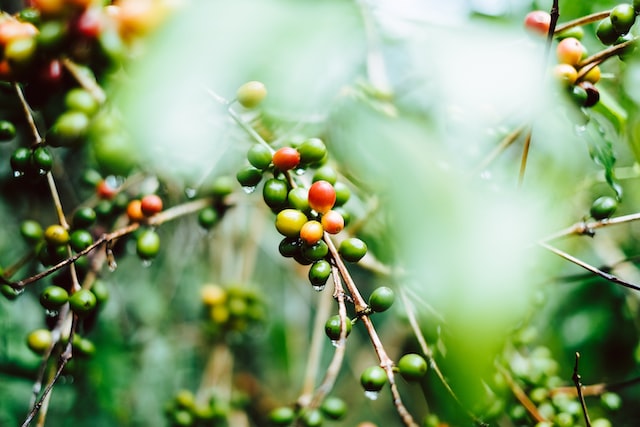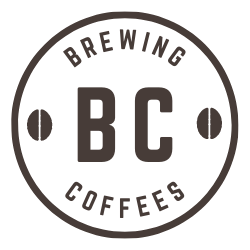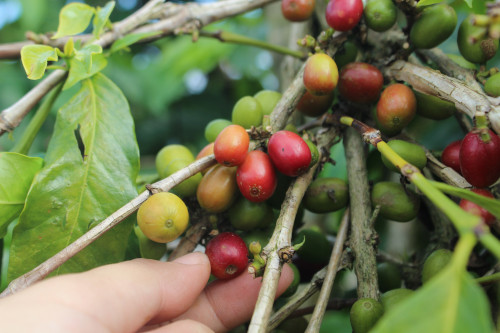Where do coffee beans come from? How do we harvest coffee beans? And is coffee a bean or is it actually something else entirely?
These are just some of the questions you might be asking yourself, and we are happy to answer.
Are Coffee Beans Really Beans?
Coffee beans are not actually beans.
Coffee trees produce a fruit called the coffee cherry and coffee beans are the seed of this cherry.
So coffee beans are really a seed, not a bean at all!
It is believed that there are between 23 and 100 different species of coffee plants that produce coffee seeds (aka. beans!).
How Does Coffee Grow?

Photo by Gerson Cifuentes,
Coffee trees are tall shrubs that produce waxy, green leaves and can take up to two years after planting to produce fruit.
They can grow as high as 9 meters, so they will typically be trimmed back. Pruning a coffee tree also helps the plant focus its energy on producing fruit.
It can take as long as five years for coffee trees to reach their full potential for fruit production. They then remain at their peak until around 20 years of age.
The coffee plant will first flower, and then the cherry will mature for a year.
Coffee cherries have an outer husk and a pulpy inner. The coffee seeds beneath the pulp consist of either two seeds with flat sides facing each other or one completely round bean, known as a peaberry.
Where Do Coffee Beans Grow?
Along with how they are cultivated, the climate and conditions where coffee cherries grow will affect their flavor.
Many types of coffee beans are grown in different regions around the world.
Arabica
The most common coffee, Coffea Arabica, makes up almost 60% of the world’s coffee beans.
There are over 20 Arabica varieties found around the world, and the plant does well in mild, humid countries.
Many countries that produce a large amount of Arabica beans are located near the equator, including Mexico, India, Colombia, Rwanda, Ethiopia, and Brazil.
Robusta
The other largest contributor to the world’s coffee bean supply is the Coffea Canephora plant which produces the Robusta bean. This accounts for nearly 40% of the world’s beans.
Robusta beans produce a more powerful, strong-tasting coffee compared to the sweeter Arabica bean. This is because they have almost two times as much caffeine per bean.
Robusta beans are typically grown in Indonesia and Africa and yield the highest amount of cherries compared to other plants. In addition, because so many beans are produced from each plant, Robusta beans are a low-cost option.
Liberica
With Arabica and Robusta beans accounting for almost all the coffee beans in production, the remaining two types – Liberica and Excelsa – have a limited impact on the global market.
Liberica beans are typically grown in the Philippines, Malaysia, and West Africa.
Excelsa
It’s debatable whether Excelsa is a type of coffee bean in its own right, as it is technically classified within the Liberica family. However, Excelsa beans have a distinct fruity flavor which differs to the taste of Liberica beans.
Excelsa beans are primarily grown in South East Asia.
How Are Coffee Beans Harvested?
Most coffee fruit will be harvested by hand to ensure they are ripe.
Sometimes they are “strip picked,” where all the ripe coffee cherry beans are taken at the same time as the unripe cherries. This is typically only done with Robusta beans.
Dry coffee bean harvesting
The dry method sees the cherries laid out in the sun to dry and regularly rotated.
Special machinery then extracts the green coffee beans before roasting them.
Wet coffee bean harvesting
The wet method of dealing with coffee cherries sees the cherries separated to dispose of the bad ones. They are then stripped of their husk before being fermented to remove pulp and fruit remnants.
It is crucial not to over-ferment the coffee seeds, so they must be regularly checked. The green coffee beans will then be dried before being roasted.
The roasted beans are ground or left whole for consumers to grind to their own specifications.
Coffee Benefits
Coffee has been shown to have many benefits for people that drink it regularly. However, it is worth noting that having your coffee with cream, sugar, or flavoring syrups may negate some of the benefits.
Nutrients
You may be surprised to hear about the health benefits of drinking coffee, but it’s true that the nutrients in coffee can help increase the metabolism of cells, increase cell health, and improve brain function.
The nutrients found in coffee include niacin, magnesium, potassium, manganese, and riboflavin.
Just one cup of coffee provides over a tenth of your body’s recommended intake of riboflavin.
Antioxidants
Ferulic acid, which is found in coffee, is an antioxidant with anti-inflammatory properties. It also has antiviral and antibacterial effects.
Disease prevention
Studies have shown that coffee can reduce the risk of some illnesses, including dementia, Alzheimer’s disease, Parkinson’s disease, type 2 diabetes, and certain cancers.
Final Thoughts
Most of us won’t think twice about what happened before a roasted coffee bean became coffee grounds for producing high-quality coffee.
However, the type of coffee beans used, how the coffee cherries grow, and the various regions used to grow each coffee plant all affect your coffee’s taste.
Coffee cherries and green beans are the first steps on the road to producing coffee. The seeds inside the ripe coffee cherry fruit are used to make everything from instant coffee to the highest quality coffee with a hefty price tag.
Frequently Asked Questions – Is coffee a bean?
Because of their looks. They have a very close resemblance to that of a bean.
Neither! Coffee beans are seeds inside a red or purple fruit called “coffee cherries”.
This is confusing. Beans are always seeds, but seeds are not always beans (!). A bean is a kind of seed. The coffee plant is not part of the bean-seed family Fabaceae (or Leguminosae). Thus, “coffee beans” are not actually beans.

Hey there! I’m Austin and I love coffee. In fact, I drink about 5 americanos a day. I started BrewingCoffees because I wanted to share my love of coffee with the world. Before starting BrewingCoffees, I worked as a Barista for 7 years.


Leave a Reply